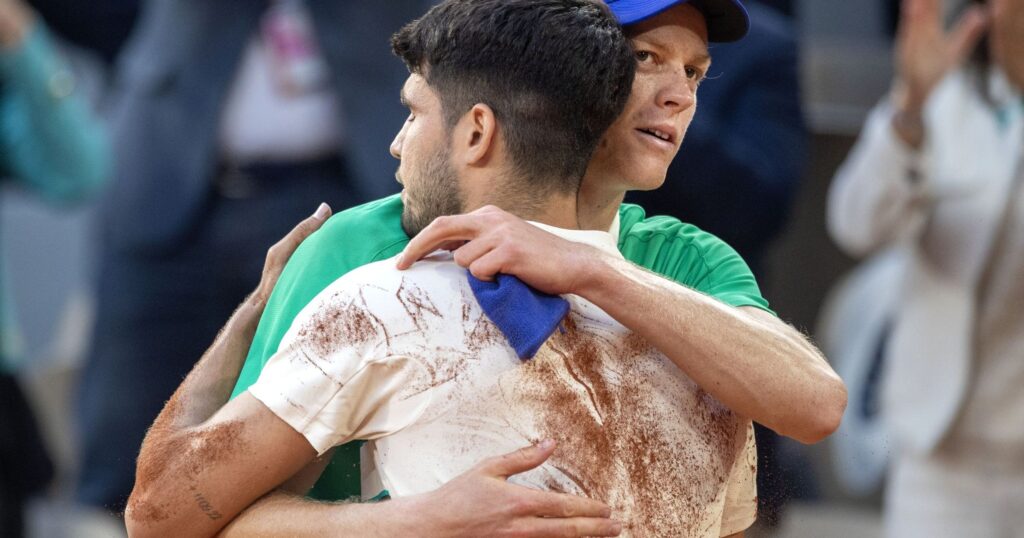The recent Grand Slam final between Carlos Alcaraz and Jannik Sinner was a momentous event in tennis history, with the match often touted as one of the most thrilling in memory. This championship clash, held at the iconic Roland-Garros, was significant not just for the extraordinary skill displayed but also for the unprecedented drama that unfolded over nearly six hours of exhilarating tennis. At five hours and 29 minutes, this contest became the longest French Open final, marking a riveting continuation of a storied rivalry that many anticipate will dominate the tennis landscape for years to come.
What made this final remarkable was the alternating momentum between Alcaraz and Sinner throughout the match. Initially, Sinner seemed to carry a momentum derived from his earlier performances in the tournament, winning the first two sets and extending his streak of consecutive sets won at the French Open. His precision and consistency cast a shadow over Alcaraz, leading many to believe Sinner was on a clear path to victory. However, Alcaraz, demonstrating not only his superior talent but also his grit and resilience as a competitor, began his impressive comeback.
Alcaraz’s comeback efforts became the centerpiece of the match’s narrative. After falling behind in the third set, he faced a daunting situation when Sinner broke his serve early in the set. Alcaraz noted he struggled with feelings of despair during those tense moments, remarking, “When he broke my serve at the beginning of the third set, I felt like everything was to his favor.” This moment, however, proved to be a crucial turning point as Sinner’s previously unshakeable performance faltered under the pressure of potential victory. His struggle culminated when he failed to capitalize on three championship points only to be met by Alcaraz’s strategic precision.
In the gripping fourth set, despite appearing to falter, Sinner regained a crucial break. However, as time pressed on and the match approached its climax, a sense of nerves became palpable, particularly during critical moments when Sinner struggled to convert his opportunities. The dramatic dichotomy of talent on display came alive when Alcaraz summoned his inner resolve, delivering powerful shots and dominating crucial moments, which would ultimately lead him to force a decisive fifth set.
As the fifth set commenced, it became evident that Sinner was battling both Alcaraz’s onslaught and physical fatigue. Nevertheless, he fought valiantly, fighting back to break Alcaraz when the reigning champion served for the match. It was during this tumultuous segment that both players delivered spectacular shots, evoking gasps from the crowd and underscoring the high stakes of the match. Finally, as they entered the championship tiebreak, it was Alcaraz’s supreme talent that shone through. Demonstrating poise under pressure, he surged to a commanding lead, securing an astounding victory that will be remembered as one for the ages.
Post-match comments from both players reflected their thoughts on the significance of this victory. Alcaraz expressed, “I think the real champions are made in those situations when you deal with that pressure, with those situations in the best way possible.” This resonant statement encapsulated not only his experience but also the broader significance of resilience in competitive sports. In contrast, Sinner, while visibly despondent over his missed opportunities, recognized the sheer intensity of the battle they had fought, affirming his readiness to improve and face Alcaraz again.
As discussions arose about where this final ranks among the greatest in tennis history, pundits cited the remarkable narrative arc of resilience, skill, and emotion shared by both players. Comparing it to iconic finals like the legendary 2008 Wimbledon clash between Rafael Nadal and Roger Federer or the prolonged Australian Open final between Nadal and Novak Djokovic, experts weighed in on the impact of this match on tennis lore. Though opinions varied, the consensus remained clear: Alcaraz versus Sinner has secured itself a place in the annals of tennis history as a testament to the sport’s capacity for drama and excitement.
In summary, the Alcaraz-Sinner final was not just a contest of skills but an illustration of the very heart of tennis. The match displayed persistence, adrenaline, and a relentless drive for victory that will resonate within the sport for years to come. The future looks bright for both players, as tennis enthusiasts eagerly anticipate their next meeting on the court.












